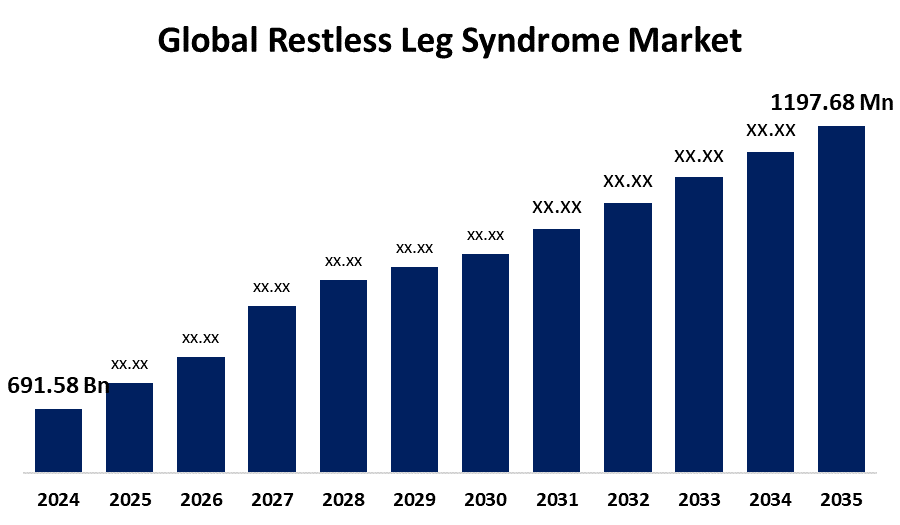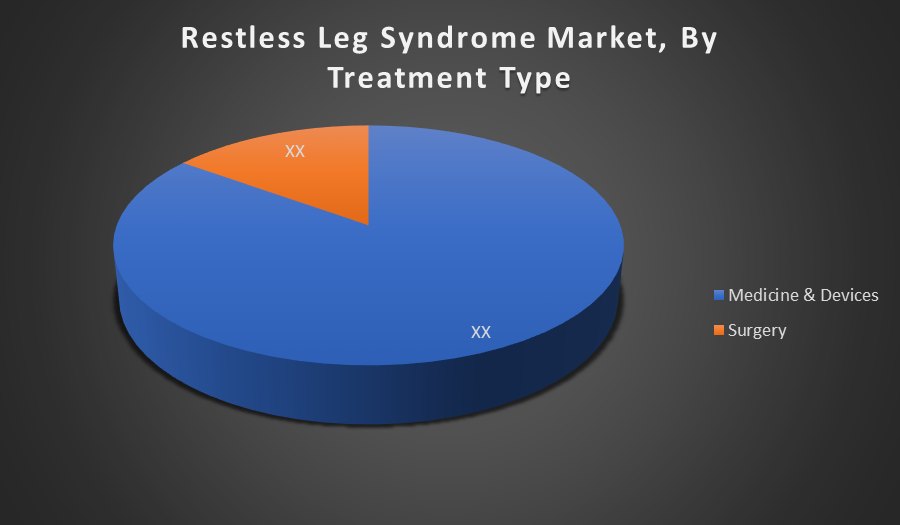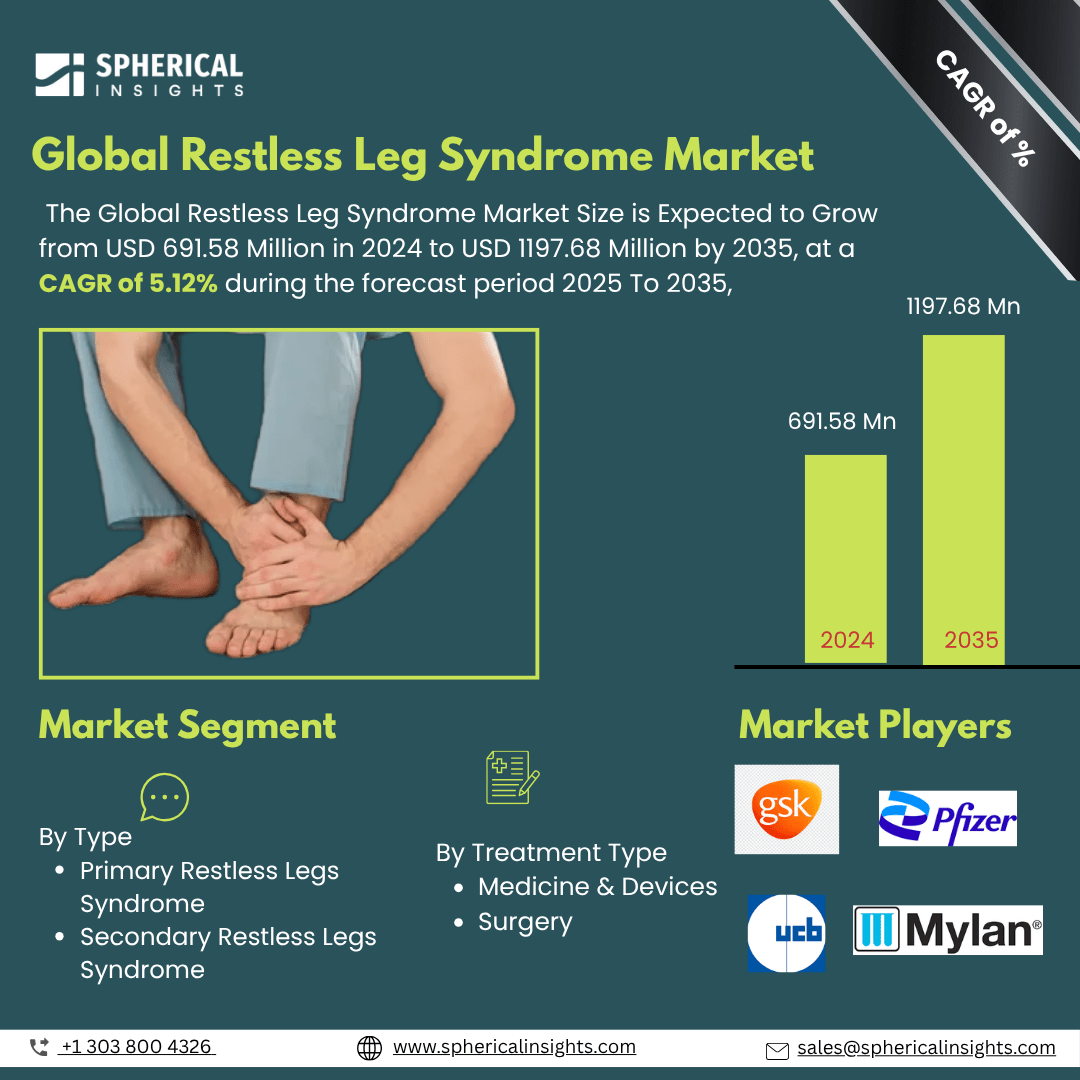Restless Leg Syndrome Treatment Market: Understanding and Treatment Algorithm:
Restless Leg Syndrome (RLS) is a neurological disorder characterized by uncomfortable sensations in the legs, causing an uncontrollable urge to move them. Symptoms worsen during rest or at night, disrupting sleep and daily activities. The exact cause is unknown but involves dopamine dysfunction and genetic factors.

Restless Leg Syndrome Diagnosis:
Diagnosis of Restless Leg Syndrome (RLS) is primarily clinical, based on patient history and symptom patterns, including the urge to move the legs and worsening symptoms at rest or night. Doctors may conduct physical exams and rule out other conditions through blood tests or sleep studies to confirm RLS and assess severity.
Restless Leg Syndrome Treatment
Treatment for Restless Leg Syndrome (RLS) includes lifestyle changes, medications, and devices. Common therapies involve dopamine agonists, iron supplements, and anticonvulsants to reduce symptoms. Non drug options like neuromodulation devices also help. Treatment aims to relieve discomfort, improve sleep, and enhance overall quality of life.
Restless Leg Syndrome Epidemiology
The disease epidemiology covered in the report provides historical as well as forecasted epidemiology segmented by Total Diagnosed Incident Population of Restless Leg Syndrome, Gender-specific Diagnosed Incidence of Restless Leg Syndrome, Type-specific Diagnosed Incidence of Restless Leg Syndrome, Age specific Diagnosed Incidence of Restless Leg Syndrome, Diagnosed Incident Population based on Primary Site of Restless Leg Syndrome, and Diagnosed Incident Population based on Histologic Classification of Restless Leg Syndrome Tumour in the global market covering North America, Europe, Asia Pacific, Latin America, the Middle East, and Africa from 2024 to 2035.
Principal Insights
Principal Insights
This section offers a global overview of restless leg syndrome epidemiology in major markets worldwide.
Country Wise Restless Leg Syndrome Multiforme Epidemiology
• The epidemiology segment provides Restless Leg Syndrome prevalence data and findings across key regions worldwide, including North America, Europe (Germany, France, Italy, Spain, and the United Kingdom), Asia Pacific (including Japan), Latin America, the Middle East, and Africa.
Restless Leg syndrome Recent Development:
• In April 2023, Noctrix Health announced that the U.S. FDA granted De Nova marketing authorizing for its NTX100 Tonic Motor Activation (TOMAC) System. This wearable, non drug device was approved to trest moderate to serve drug resistant restless legs syndrome, delivering targeted personal nerve stimulation to improve symptoms and sleep quallity
Restless Leg Syndrome Marketed Drugs:
Neupro (rotigotine) is a transdermal patch delivering a dopamine agonist used for moderate-to-severe RLS. It provides continuous drug delivery over 24 hours, helping to reduce leg discomfort and improve sleep quality. It is FDA approved for both RLS and Parkinson’s disease.
- Horizant: GlaxoSmithKline/XenoPort
Horizant (gabapentin enacarbil) is an extended-release oral tablet approved for moderate-to-severe primary RLS. It is a prodrug of gabapentin that modulates calcium channels, reducing nerve excitability and easing RLS symptoms, particularly during nighttime.
- Mirapex: Boehringer Ingelheim
Mirapex (pramipexole) is a dopamine agonist prescribed for moderate to severe RLS. It works by stimulating dopamine receptors in the brain, helping to control the urge to move the legs. It is also approved for Parkinson’s disease.
Restless Leg Syndrome: Emerging Therapies:
- NTX100: It is a wearable, non drug neuromodulation device in advanced development for drug resistant RLS. It delivers targeted stimulation to the peroneal nerve during sleep, aiming to reduce symptoms and improve sleep quality. Recently authorized by the FDA under De Novo classification, it represents a novel, device based approach to treating moderate to severe RLS.
- LY03003: It is a rotigotine extended release injection being studied for RLS. It is designed to offer long-term symptom control via sustained dopamine agonist delivery, potentially reducing the need for daily dosing and minimizing augmentation risks common with existing oral therapies.
- REL 1017: Though primarily in trials for depression, REL 1017 is an NMDA receptor modulator showing potential for off label RLS treatment. Its neuroactive properties may help regulate sensory discomfort and limb movement in patients unresponsive to standard dopaminergic therapy.
- Vly 686: Tradipitant is a neurokinin 1 (NK1) receptor antagonist initially developed for nausea. It is being investigated for off-label use in RLS due to its potential role in modulating central nervous system pathways involved in discomfort and movement disorders.
Restless Leg Syndrome Market Outlook
- The Restless Leg Syndrome (RLS) market encompasses drugs, devices, and therapies developed to manage symptoms such as uncomfortable leg sensations and sleep disturbances. It includes pharmacological treatments, neuromodulation devices, and emerging non invasive technologies aimed at improving patient quality of life and long term symptom control.
- Key drivers of the RLS market include rising awareness of the disorder, increasing prevalence among aging populations, and advancements in diagnosis. Demand is further supported by expanded therapeutic options, improved healthcare access, and growing investments in neuroscience and sleep medicine by pharmaceutical and medical device companies.
- Opportunities exist in the development of non invasive treatments, wearable neuromodulation devices, and extended release medications with reduced side effects. Unmet needs in drug resistant RLS cases, along with a growing patient population in emerging economies, present avenues for innovation and market expansion across both developed and developing regions.
- Governments are supporting neurological disorder research through funding, awareness campaigns, and improved diagnostic frameworks. Public health bodies in the U.S. and EU promote early screening and facilitate clinical trials by offering designations like breakthrough or orphan status to novel RLS treatments.
- Limited treatment efficacy and drug related side effects remain key challenges in managing RLS effectively.
- The market is projected to grow steadily due to increased demand for non-dopaminergic, long term, and non-invasive treatment alternatives.
Restless Leg Syndrome Market Segmentation
By Type:
- Primary Restless Legs Syndrome
- Secondary Restless Legs Syndrome

Primary Restless Legs Syndrome holds the largest market share due to its higher prevalence, particularly among older adults. It often presents as an idiopathic condition with no underlying cause, making long-term management essential. This leads to sustained demand for chronic treatment options, supporting its dominant position in the global market.
By Treatment Type:
- Medicine & Devices
- Surgery

Medicine & Devices account for the largest share, as pharmacological treatments like dopamine agonists and iron supplements are the first-line options. Additionally, medical devices such as pneumatic compression and vibrating pads offer non-invasive symptom relief. Their accessibility, ease of use, and widespread acceptance among patients ensure market dominance over surgical alternatives.
Regional Segment Analysis of the Restless Leg Syndrome Market
North America holds the largest share in the restless leg syndrome (RLS) market due to its high disease awareness, well-established healthcare infrastructure, and access to advanced diagnostic and treatment options. A large aging population and increased prevalence of primary RLS contribute to higher demand. Additionally, strong pharmaceutical presence, ongoing clinical trials, and favourable reimbursement policies further support the region’s leading position in the global RLS therapeutics market.
Asia-Pacific is the fastest-growing region in the RLS market, driven by rising awareness, growing healthcare investments, and increasing diagnosis rates. Urbanization and lifestyle shifts are contributing to more reported cases of RLS. Expanding access to neurology care, supportive government initiatives, and growing elderly populations also promote market growth. Additionally, the increasing entry of global pharma companies into emerging economies enhances treatment availability and fuels regional expansion.
Restless Leg Syndrome Market Key Companies
- GlaxoSmithKline
- Pfizer
- UCB Pharma
- Mylan
- Boehringer Ingelheim
- Teva Pharmaceuticals
- Novartis
- Bayer
- Sanofi
- Merck & Co.
- Arbor Pharmaceuticals
- XenoPort
- Acorda Therapeutics
- Glenmark Pharmaceuticals
- Sun Pharmaceutical Industries
- Others
Restless Leg Syndrome Therapeutics Market Report Scope
- The Restless Leg Syndrome therapeutics market report provides a detailed overview, covering its causes, symptoms, disease progression, and existing treatment options.
- Detailed insights into Restless Leg Syndrome’s epidemiology and therapeutic approaches are included.
- Additionally, a comprehensive review of existing and emerging Restless Leg Syndrome therapies is provided, including an evaluation of new treatments expected to influence the current Restless Leg Syndrome treatment market landscape.
- The report includes a detailed review of the Restless Leg Syndrome therapeutics market, both historical and forecasted, highlighting the global drug reach.
- The Patient-Based Restless Leg Syndrome Market Forecasting report offers valuable insights into trends shaping the global Restless Leg Syndrome market, helping to develop effective business strategies.
Restless Leg Syndrome Treatment Market Report Insights
- Forecasting Market Trends Based on Patient Data and Disease Rates
- Restless Leg Syndrome Therapeutic Approaches in Restless Leg Syndrome
- Review Of Drugs in Development for Restless Leg Syndrome
- Market, Growth, and Trends in Restless Leg Syndrome
- Market Opportunities in Restless Leg Syndrome Treatment
- Effects Of Future Therapies on Restless Leg Syndrome Treatment.
Restless Leg Syndrome Treatment Market Report Key Strengths
- 15 Years Restless Leg Syndrome Market Forecast
- Global Coverage
- Restless Leg Syndrome Epidemiology Segmentation
- Key Cross Competition
Restless Leg Syndrome Treatment Market Report Assessment
- Present Practices in the Restless Leg Syndrome Treatment Market
- Review of Investigational Restless Leg Syndrome Drugs
- Attractiveness of the Restless Leg Syndrome Drug Market
- Restless Leg Syndrome Market Drivers
- Restless Leg Syndrome Market Barriers
- SWOT
- Attribute Analysis
Market Segment
This study forecasts revenue at the global, regional, and country levels from 2020 to 2035. Spherical Insights has segmented the restless leg syndrome market based on the below-mentioned segments:
Global Restless Leg Syndrome Market, By Type
- Primary Restless Legs Syndrome
- Secondary Restless Legs Syndrome
Global Restless Leg Syndrome Market, By Treatment Type
- Medicine & Devices
- Surgery
Global Restless Leg Syndrome Market, By Regional Analysis
- North America
- Europe
- Germany
- UK
- France
- Italy
- Spain
- Russia
- Rest of Europe
- Asia Pacific
- China
- Japan
- India
- South Korea
- Australia
- Rest of Asia Pacific
- South America
- Brazil
- Argentina
- Rest of South America
- Middle East & Africa
- UAE
- Saudi Arabia
- Qatar
- South Africa
- Rest of the Middle East & Africa






